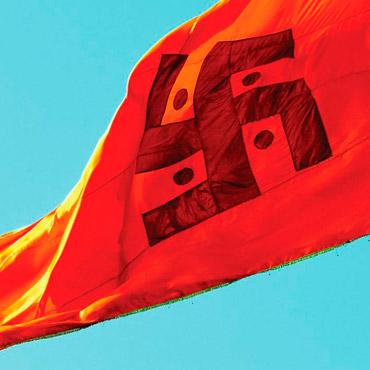Why in the next Tokyo 2020 Olympic Games we will have to get used to seeing swastikas
The swastika is a symbol of peace, prosperity and good luck for about 2.3 billion people, a third of the world's population. Most of them are found in Asia, where it is a sacred emblem for Buddhism, Hinduism, Jainism, and Odinism. That is what the Buddhist monk Rev Dr. TK Nakagaki thought when in April 1986, just arrived in the United States, he made a chrysanthemum swastika to celebrate the Buddha's birthday and placed it in his temple in Seattle (Washington). His companions panicked. "You can't do that," they yelled at him. It was the moment of his awakening. The last time he used it in the West.
Nakagaki is today one of the most influential Buddhist monks in the US, president of the Heiwa Foundation for Peace and Reconciliation in New York, a noted calligrapher, and a man on a mission: to rescue the swastika from the forces of the hate.
"If I could convince just 1% it would be a success," says Nakagaki. He has just published his book titled The Buddhist Swastika and the Hitler Cross (Stone Bridge Press). with which he intends to shed a little light on the history and the ancient meaning of the symbol that we associate today with Nazi horror. He is aware of the skepticism that his effort arouses.
This year, his crusade will obtain a small victory on the occasion of the Tokyo 2020 Olympic Games. This cultural shock was precisely the subject of debate in Japan, where the manji (the Japanese swastika) is used to locate Buddhist temples on maps, religion professed by some 46 million people in the country. Hence, in 2016, the Japan Geospatial Information Authority (GSI) launched a public consultation to remove the manji from maps so as not to offend the sensibilities of visitors to the Olympic Games. After massive support for their permanence, they decided that foreigners should get used to their vision, and the swastika does not appear in the list of symbols that will be modified to make the maps more understandable for them.
The Nazi kidnapping of a world symbol
Since Adolf Hitler kidnapped it in 1920 to make it the trademark of the Third Reich, it has become the graphic representation of anti-Semitism, hatred and racial superiority. Under Nazi flags and banners, more than six million people died between 1935 and 1945. Nakagaki's efforts have left Western pundits with a question: Is the swastika redeemable?
"The image is so powerful from a design point of view that its impact is unprecedented in history," explains Steven Heller, an authority on visual criticism, responsible for 30 years of graphic image of The New York Times and co-president from the New York School of Visual Arts (SVA).
Heller is obsessed with the use made of it by the Nazi regime and its significance over the years. He is one of those who thinks that "she will never be redeemed", unlike his friend Nakagaki. He has also just written a book on the subject, the third in his bibliography, under the title The Swastika and the Symbols of Hate: The Iconography of Extremism Today (Allworth Press). He is convinced that, as long as the extreme right continues to spread its message in the US and Europe, it will continue to be used as an expression of hatred against those who are different.
"Hitler's swastika is only 100 years old in the face of a thousand-year history," recalls Nakagaki. The origin of the cross with two interlocking hooks dates back 5,000 years to the valleys of the Indus River (India). The word "swastika" comes from the Sanskrit svastica, which means "good fortune" or "welfare." Its religious and secular uses multiplied throughout history. "There are swastikas all over the world that have nothing to do with the Nazis," explains Heller.
From before Christ are those that appear at the feet of the Buddhas carved in the mountains of northern India, in the Koban necropolis in the Caucasus of North Ossetia, in the ancient city of Troy (Turkey), in the remains from Mycenae, in the ruins of Babylon (Iraq) or in the ornaments of the Ashanti tribe in Ghana. Archaeological excavations place the swastika on the American continent before the arrival of Christopher Columbus: the natives stamped it on pottery, rugs, clothing and jewelry.

the fact that I'm seeing multiple threads on the tl of how to treat a gunshot wound makes me so sick to my stomach.… https://t.co/16GPilkZqf
— rea | SHANNON DAY Fri May 29 05:43:11 +0000 2020
The most surprising thing for the Western mind is how in the 1920s and 1930s it became a trademark in the US. In 1925, Coca Cola produced a good luck badge in the shape of a swastika with the inscription "Drink Coca Tail". The Boy Scouts printed it on postcards, clothing, jewelry, or merit badges.
Sports teams used it to represent the four L's: "Love, life, light, luck" ("love, life, light and luck", in its Spanish version). It was a very common ornament in the architecture of the early twentieth century. In New York, it can be found on the roof of the Columbia University bookstore, at the entrance to the Metropolitan Museum, or on the façade of the Brooklyn Academy of Music. It appeared on postcards, cookie marks, and even in Hollywood westerns until Hitler got hold of it.
The Native Americans of the Navajo, Apache, Papago and Hopi were the first to rebel against its use by the Nazis. In 1940, in protest, they stopped using it forever with a public declaration and the burning of all their objects that had it stamped on it.
In Europe, it spread as a common mystical insignia in the decoration of Catholic abbeys and convents. It can be found in the Cathedral of Amiens (France), in Oxford (England) or in the Benedictine monastery of Lambach, in the north of Upper Austria, where it is believed that Hitler had his first contact with it when he was a child as part of the chorus.
Later theories are divided between those who, like Nakagaki, consider that it was copied from the journalist and former Catholic monk Jörg Lanz von Liebenfels, founder of the Order of the New Templars, in 1907. An anti-Semitic organization that promoted the superiority of the Aryan race and that he adopted it as his insignia. Hitler is known to have met with Lanz to get copies of the Ostara publication from him.
Others, like Heller, speculate that he stole it from the Berlin graphic designer Wilhelm F. Deffke, one of the inventors of the corporate logo, a member of the Bauhaus and the Ring Neuer Werbegestalter (Circle of New Advertising Designers).
This was confessed by her assistant, Mana Tress, in a letter written in the seventies to the renowned American graphic designer Paul Rand. "He didn't pay for it," Tress wrote. Deffke's swastika appeared in a self-published book as a reinterpretation of the sunwheel of German tradition.
What is clear is that Hitler seized it in the summer of 1920, after turning it to the right by 45 degrees on its axis. In his book, Mein Kampf ("my fight"), published five years later, Hitler described its meaning for National Socialism and how it should be used. Painted black, on a white circle and with a red background, the colors of the old flag of the German Empire.
On December 2, 1923, it first appeared named in The New York Times as the Hakenkreuz ("hook cross"), in an article where an eyewitness described a scene inside Munich's Bürgerbräukeller beer hall, where Hitler made his attempted assassination. coup a month earlier. From this day on, the press will refer to it as "the Nazi symbol."
Its effectiveness would not have been possible without the Nazi propaganda minister, Joseph Goebbels, who on May 19, 1933 published the "Law for the Protection of National Symbols", which ensured the exploitation of the brand and prohibited its commercial use. The Nazi government ordered it to be flown over all official buildings in Germany. And it ended up hanging in Poland, the Netherlands, around the Eiffel Tower and in the Parthenon in Greece.
Seventy-four years after the end of World War II, the swastika remains an obscene symbol in the West. Almost daily the press publishes headlines like these: "A swastika appears on Trump's plaque on the walk of fame", "A swastika is painted on the anti-Nazi monolith in Segovia". Perhaps for this reason, the international press echoed the Japanese consultation on whether to remove or keep the manji on the maps: "The controversial swastikas that Japan wants to remove from its maps," was read from London to New York. But what the media has not picked up is the final decision in favor of the traditional symbology of the temples. The swastika stays. "It would be nice if someone told it," Nakgaki suggests.







![47 best antiage nutritive cream in 2022 [based on 326 reviews] 47 best antiage nutritive cream in 2022 [based on 326 reviews]](https://website-google-hk.oss-cn-hongkong.aliyuncs.com/drawing/article_results_6/2022/2/27/1918fc37c66ad30564173e69d9df88a0.jpeg)
